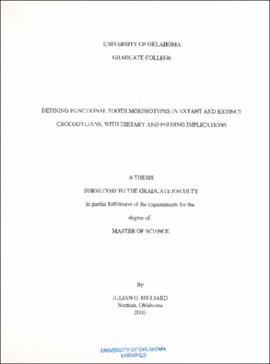| dc.description.abstract | Crocodylians have traditionally been considered to have homodont dentitions (eg., Kalin, 1933; Langston, 1973). Although all the teeth in these species are cone-shaped, there is a large amount of morphological variation present, which has prompted some authors to describe crocodylian dentitions as heterodont (eg., Kieser et al., 1993; Aoki, 1989). Furthering such observations, ten modern crocodylian species were sampled and their teeth measured in four aspects. These data were processed using principal components and cluster analyses, and functional tooth morphs were defined within each species. Tooth morphs (here termed "functional morphotypes") were then correlated with dietary and feeding information gleaned from other studies. An ontogenetic series of Alligator mississippiensis skulls was used to test for ontogenetic changes in the dentition. While many have reported that crocodylian teeth change shape ontogenetically (eg., Langston, 1973; Westergaard, 1990), no significant ontogenetic changes in tooth shape were found to occur. This finding lends greater importance to all research concerning crocodylian tooth morphology. Finally, a random sample of Cretaceous age crocodyliform teeth from the Cedar Mountain Formation in Utah (OMNH site V695) was tested using the preceding methodology to discover the number of tooth morphotypes and species present in this sample. Based on the large number of morphotypes defined, at least three species are represented. The low degree of clarity gleaned from this part of the study, however, urges caution in applying generic and family-level designations to isolated fossilized teeth. Moreover, the high degree of heterodonty present in fossil taxa suggests that only the most conservative identifications be attempted until more is known about the dentitions of fossil crocodyliform taxa. | |
